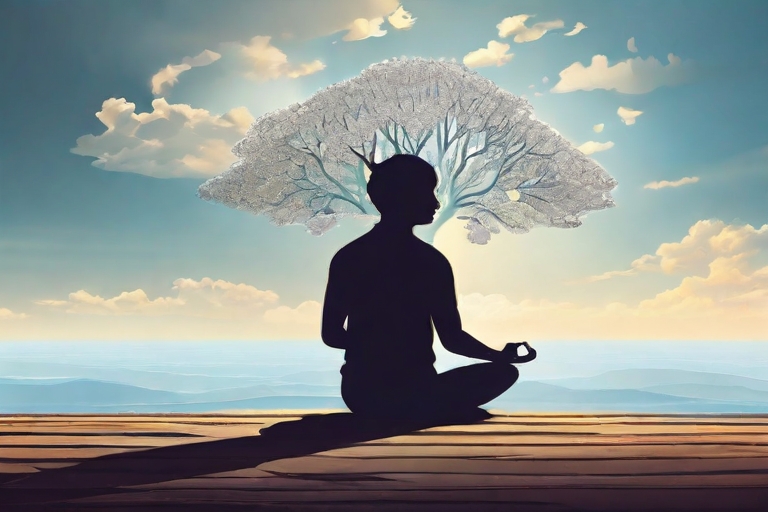Yoga, an ancient practice that has the power to transform both the body and the mind, invites us on a remarkable journey towards wellness. In this article, we will embark on an exploration of the myriad benefits of and how it can help you achieve a state of physical, mental, and emotional well-being. From the origins of yoga to the diverse styles and practices, we will delve into the ways in which this holistic approach to wellness can enrich your life. Whether you’re a seasoned practitioner or new to the world, this guide will provide you with the knowledge and inspiration to unlock the transformative power of this timeless discipline.
Key Takeaways
- Yoga is an ancient practice that has the power to transform both the body and the mind.
- This article explores the benefits of and how it can help you achieve physical, mental, and emotional well-being.
- We will delve into the origins of and the diverse styles and practices that can enrich your life.
- Whether you\’re a seasoned practitioner or new to this discipline, this guide will provide you with the knowledge and inspiration to unlock the transformative power of this timeless discipline.
- The article will cover the physical, mental, and emotional benefits of yoga, as well as different types of yoga and how to find the right fit for your needs.
Yoga: An Ancient Practice for Modern Times
Yoga, an ancient practice that originated in the lush landscapes of India, has transcended the boundaries of time and space to become a global phenomenon. This holistic discipline, rooted in a rich tapestry of spiritual and philosophical traditions, has evolved to meet the ever-changing needs of modern practitioners. From the depths of the Vedas and the Upanishads to the wisdom of the Bhagavad Gita and the Sutras, the foundations have withstood the test of centuries, providing a timeless gateway to physical, mental, and emotional well-being.
Unveiling the Origins of Yoga
The origins can be traced back to the Indus Valley Civilization, where the practice emerged as a means of harmonizing the body, mind, and spirit. The earliest recorded references can be found in the Vedas, the ancient sacred texts that form the foundation of Hindu philosophy. These ancient scriptures, such as the Rig Veda and the Upanishads, articulate the fundamental principles and practices of Buddhism, including the concepts of meditation, mindfulness, and the integration of the self with the divine.
As it evolved over the centuries, it became a multifaceted discipline encompassing a wide range of physical postures (asanas), breathing techniques (pranayama), and meditative practices. The Bhagavad Gita, a revered text within the Hindu tradition, further expanded the understanding of yoga, introducing the concept of yoga of action” and the harmonious integration of spiritual and worldly pursuits.
The Evolution of Yoga Through the Ages
Throughout history, it has continued to adapt and transform, responding to the changing needs and aspirations of its practitioners. In the late 19th and early 20th centuries, yoga experienced a significant resurgence, with influential figures like Swami Vivekananda and Krishnamacharya playing a pivotal role in introducing the practice to the West. These pioneering yogis not only shared the physical aspects of yoga but also emphasized its philosophical and spiritual dimensions, laying the groundwork for its global popularity today.
As it has spread across the world, it has continued to evolve, giving rise to diverse styles and approaches that cater to the unique needs and preferences of modern practitioners. From the dynamic flow of Vinyasa yoga to the restorative practices of Yin yoga, the modern yoga landscape offers a rich tapestry of choices, empowering individuals to find the style that resonates most deeply with their personal goals and well-being.
Personalized Weight Loss with 1Custom Keto Diet
The Physical Benefits of Yoga

Yoga is renowned for its ability to improve physical well-being, and in this section, we will delve into the specific ways in which it can benefit the body. The practice of various yoga asanas (postures) can increase flexibility and muscle strength, leading to a more balanced and aligned physique. Additionally, it can enhance posture and improve balance, contributing to a greater sense of stability and ease of movement.
Increased Flexibility and Strength
One of the primary physical benefits of a consistent practice is the development of increased flexibility. As you move through the various poses, your muscles are gently stretched and lengthened, helping to improve their range of motion. This increased flexibility not only enhances your overall physical capabilities but also reduces the risk of injury during other physical activities.
In addition to flexibility, it also builds muscular strength. The weight-bearing asanas, such as plank, warrior poses, and arm balances, require you to engage and activate various muscle groups. Over time, this strengthening of the muscles leads to a more toned and balanced physique, better posture, and improved overall physical performance.
Improved Posture and Balance
Another significant physical benefit is its ability to enhance posture and balance. Many yoga poses focus on aligning the spine, strengthening the core, and improving overall body awareness. As you become more attuned to your body\’s alignment and balance, you\’ll notice improvements in your posture, both during your yoga practice and in your daily activities.
Furthermore, it incorporates a strong emphasis on proprioception, or the body\’s ability to sense its position and movements in space. This awareness, coupled with the strengthening of stabilizing muscles, leads to enhanced balance and coordination, which can be particularly beneficial for older adults or individuals prone to falls.
By understanding the physical transformations that can occur through consistent practice, readers will be empowered to embark on their own journey of physical wellness.
GET ALL PRODUCTS HEALTHY
The Mental and Emotional Benefits of Yoga
Yoga is not just a physical practice; it also has profound effects on the mind and emotions. In this section, we will explore the ways in which yoga can positively impact mental and emotional well-being. We will delve into the benefits of the meditative and mindful aspects of mindfulness, such as reduced stress and anxiety, increased focus and concentration, and enhanced self-awareness.
Additionally, we will discuss how breathwork (pranayama) and philosophical teachings can foster a greater sense of inner peace, emotional balance, and overall life satisfaction. By understanding the holistic nature of this practice, readers will be inspired to incorporate it into their lives as a means of achieving true wellness.
Types of Yoga and Finding the Right Fit
The world is vast and diverse, with numerous styles and approaches to cater to different needs and preferences. In this section, we will explore some of the most popular types of yoga, including Hatha, Vinyasa Flow, and Restorative Yoga, to help you determine which practice might be the best fit for your individual goals and preferences.
Hatha Yoga: A Gentle Introduction
Hatha yoga is often considered a great starting point for beginners, as it focuses on the physical poses (asanas) and the breath. This style is characterized by a slower pace, allowing practitioners to deeply explore each pose and cultivate a greater awareness of the body. Hatha is an excellent choice for those seeking a gentle, restorative practice that promotes flexibility, strength, and overall well-being.
Vinyasa Flow: A Dynamic Yoga Style
Vinyasa flow is a more dynamic and energetic practice that links breath with movement. This style of yoga is known for its fluid sequences, where practitioners seamlessly transition from one yoga pose to the next. Vinyasa Flow can be a great option for those seeking a more challenging and invigorating practice, as it often includes a higher intensity and faster-paced flow of poses.
Restorative Yoga: A Calming Practice
In contrast to the more active styles of yoga, restorative yoga is a gentle, soothing practice that focuses on deep relaxation and restoration. This style utilizes props, such as bolsters, blankets, and blocks, to support the body in poses that are held for an extended period of time. Restorative therapy can be particularly beneficial for those seeking to reduce stress, alleviate anxiety, and cultivate a greater sense of inner peace.
By understanding the unique characteristics of these different styles, you can determine which approach aligns best with your personal needs, preferences, and goals. Whether you\’re drawn to the gentle Hatha yoga practice, the dynamic Vinyasa Flow, or restorative yoga, exploring the diverse world of restorative yoga will empower you to find a practice that supports your journey towards optimal well-being.
Meditation and Pranayama: Complementary Practices
Yoga is not complete without the practices of meditation and pranayama (breath control). In this final section, we will explore the intrinsic connection between these complementary disciplines and how they can enhance transformative power.
Mindfulness Meditation Techniques
We will delve into the various mindfulness meditation techniques that can be integrated into a yoga practice, such as focused attention, open monitoring, and loving-kindness meditation. These practices can help cultivate a deeper sense of presence, awareness, and emotional well-being, perfectly complementing the physical aspects.
Pranayama: The Art of Conscious Breathing
Additionally, we will discuss the art of pranayama, the ancient practice of conscious breathing, and how it can be used to cultivate a deeper state of relaxation, focus, and self-awareness. By understanding the synergistic relationship between yoga, meditation, and pranayama, readers will be equipped with a comprehensive toolkit to embark on their journey towards holistic wellness.
FAQ
What is yoga and what are its benefits?
Yoga is an ancient practice that integrates the body, mind, and spirit. It offers a wide range of physical, mental, and emotional benefits, including increased flexibility and strength, improved posture and balance, reduced stress and anxiety, enhanced focus and concentration, and a greater sense of inner peace and well-being.
What are the different styles of yoga?
Some of the most popular styles include Hatha (a gentle approach), Vinyasa Flow (a dynamic, flowing practice), and Restorative (a calming, deeply relaxing practice). Each style has its own unique characteristics and emphasis, so it\’s important to explore different options to find the one that best suits your individual needs and preferences.
How can yoga improve physical health?
Yoga can significantly improve physical health in several ways. The practice of various poses, or asanas, can increase flexibility and muscle strength, leading to a more balanced and aligned body. Yoga can also enhance posture and improve balance, contributing to greater stability and ease of movement.
How does yoga benefit mental and emotional well-being?
Yoga\’s mental and emotional benefits are just as profound as its physical benefits. The meditative and mindful aspects of yoga can help reduce stress and anxiety, increase focus and concentration, and foster a greater sense of self-awareness and inner peace. Breathwork (pranayama) and philosophical teachings can also promote emotional balance and overall life satisfaction.
What is the role of meditation and pranayama in a yoga practice?
Meditation and pranayama (breath control) are integral components of a holistic yoga practice. Mindfulness meditation techniques can be seamlessly integrated into yoga, enhancing focus, relaxation, and self-awareness. Pranayama, the ancient art of conscious breathing, can further deepen the transformative effects of yoga by cultivating a state of inner calm and equilibrium.
How do I choose the right yoga studio and instructor?
When selecting a yoga studio and instructor, it\’s important to consider factors such as the studio\’s atmosphere, the instructor\’s teaching style and qualifications, and the alignment of the classes with your personal goals and preferences. It\’s also a good idea to try out a few different classes and studios before committing to one, to ensure you find the perfect fit for your yoga journey.


